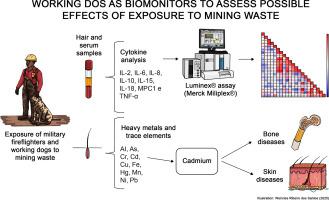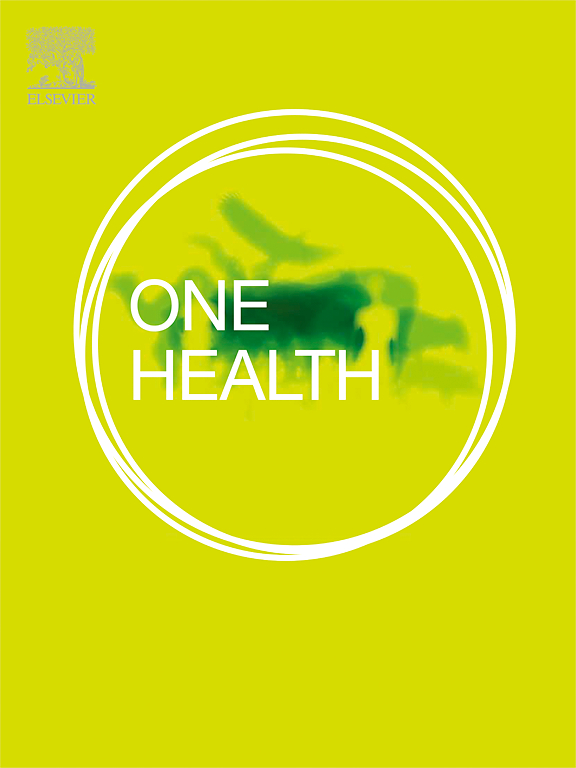Evaluation of the effects of exposure to heavy metals in rescue dogs and their role as environmental biomonitors after the Brumadinho disaster, Minas Gerais, Brazil
IF 4.5
2区 医学
Q1 INFECTIOUS DISEASES
引用次数: 0
Abstract
In January 2019, a mining dam collapsed in Brumadinho, Minas Gerais, Brazil. Numerous professionals from fire brigades from several states in Brazil and trained dogs worked to rescue the victims of this tragedy and maintained direct contact with the dam's tailings. To understand the consequences generated by this exposure, a cross-sectional observational study, heavy metals, cytokines and clinical signs were correlated, was carried out with the aim of identifying biological biomarkers and the presence of metals in trained dogs. Hair and serum samples from 30 rescue dogs from the Military Fire Brigade were used to analyze heavy metals, trace elements and cytokines. Among these, 20 dogs were exposed to tailings and 10 were not involved in mining disasters. Cadmium metal obtained a significant result (p = 0.013) when compared with the exposure to waste and a negative correlation (-0.58) with IL-15 (p = 0.01). The clinical signs that presented significant values were dermatological (p = 0.011) and locomotor (p = 0.003). Of the exposed dogs (6/20) 30 %, had neoplasms in the skin and reproductive system. The dogs in the exposed group showed a positive correlation (0.49) between Lead and the number of hours worked (p = 0.02) and a positive correlation (0.48) with Chromium (p = 0.03). The correlation between clinical signs, presence of metals and inflammatory cytokines indicates that dogs can be a promising tool for characterizing long-term occupational exposures and highlights the importance of biomonitoring the health of firefighters who suffer constant environmental exposures.

巴西米纳斯吉拉斯Brumadinho灾难后救援犬重金属暴露影响及其环境生物监测作用的评估
2019年1月,巴西米纳斯吉拉斯州布鲁马迪尼奥的一座矿坝坍塌。来自巴西几个州的消防队的许多专业人员和训练有素的狗一起努力营救这场悲剧的受害者,并与大坝的尾矿保持直接联系。为了了解这种暴露所产生的后果,进行了一项横断面观察研究,重金属、细胞因子和临床症状之间存在相关性,目的是确定生物生物标志物和受过训练的狗体内金属的存在。来自军事消防队的30只救援犬的毛发和血清样本被用来分析重金属、微量元素和细胞因子。其中,20只犬接触过尾矿,10只犬未参与矿难。与接触废物相比,镉金属获得显著结果(p = 0.013),与IL-15呈负相关(-0.58)(p = 0.01)。具有显著意义的临床体征为皮肤(p = 0.011)和运动(p = 0.003)。暴露犬(6/20)中有30%的皮肤和生殖系统出现肿瘤。暴露组的狗显示铅与工作时数呈正相关(0.49)(p = 0.02),与铬呈正相关(0.48)(p = 0.03)。临床症状、金属和炎症细胞因子之间的相关性表明,狗可以成为表征长期职业暴露的有前途的工具,并强调了对持续暴露于环境中的消防员进行生物监测的重要性。
本文章由计算机程序翻译,如有差异,请以英文原文为准。
求助全文
约1分钟内获得全文
求助全文
来源期刊

One Health
Medicine-Infectious Diseases
CiteScore
8.10
自引率
4.00%
发文量
95
审稿时长
18 weeks
期刊介绍:
One Health - a Gold Open Access journal.
The mission of One Health is to provide a platform for rapid communication of high quality scientific knowledge on inter- and intra-species pathogen transmission, bringing together leading experts in virology, bacteriology, parasitology, mycology, vectors and vector-borne diseases, tropical health, veterinary sciences, pathology, immunology, food safety, mathematical modelling, epidemiology, public health research and emergency preparedness. As a Gold Open Access journal, a fee is payable on acceptance of the paper. Please see the Guide for Authors for more information.
Submissions to the following categories are welcome:
Virology,
Bacteriology,
Parasitology,
Mycology,
Vectors and vector-borne diseases,
Co-infections and co-morbidities,
Disease spatial surveillance,
Modelling,
Tropical Health,
Discovery,
Ecosystem Health,
Public Health.
 求助内容:
求助内容: 应助结果提醒方式:
应助结果提醒方式:


